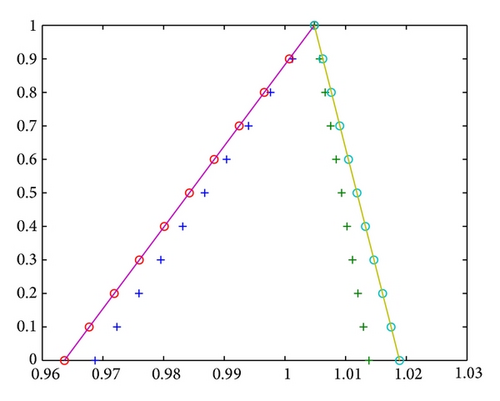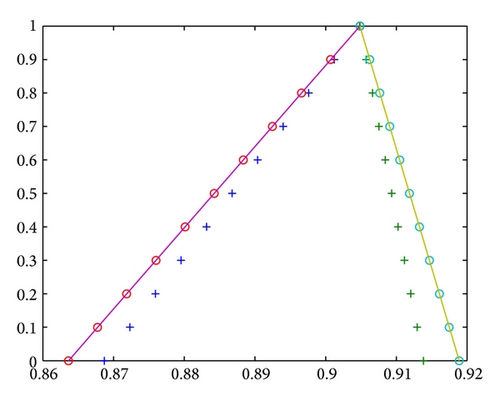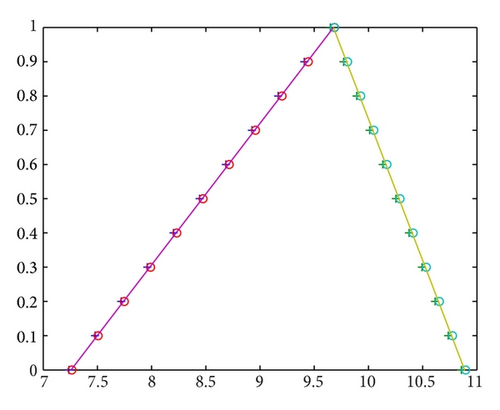A Numerical Method for Fuzzy Differential Equations and Hybrid Fuzzy Differential Equations
Abstract
Numerical algorithms for solving first-order fuzzy differential equations and hybrid fuzzy differential equations have been investigated. Sufficient conditions for stability and convergence of the proposed algorithms are given, and their applicability is illustrated with some examples.
1. Introduction
Hybrid systems are devoted to modeling, design, and validation of interactive systems of computer programs and continuous systems. That is, control systems that are capable of controlling complex systems which have discrete event dynamics as well as continuous time dynamics can be modeled by hybrid systems. The differential systems containing fuzzy valued functions and interaction with a discrete time controller are named hybrid fuzzy differential systems.
The Hukuhara derivative of a fuzzy-number-valued function was introduced in [1]. Under this setting, the existence and uniqueness of the solution of a fuzzy differential equation are studied by Kaleva [2, 3], Seikkala [4], and Kloeden [5]. This approach has the disadvantage that it leads to solutions which have an increasing length of their support [2]. A generalized differentiability was studied in [6–8]. This concept allows us to resolve the previously mentioned shortcoming. Indeed, the generalized derivative is defined for a larger class of fuzzy-number-valued functions than the Hukuhara derivative. Some applications of numerical methods in FDE and hybrid fuzzy differential equation (HFDE) are presented in [9–19]. Some other approaches to study FDE and fuzzy dynamical systems have been investigated in [20–22].
In engineering and physical problems, Trapezoidal rule is a simple and powerful method to solve numerically related ODEs. Trapezoidal rule has a higher convergence order in comparison to other one step methods, for instance, Euler method.
In this work, we concentrate on numerical procedure for solving FDEs and HFDEs, whenever these equations possess unique fuzzy solutions.
In Section 2, we briefly present the basic definitions. Trapezoidal rule for solving fuzzy differential equations is introduced in Section 3, and convergence and stability of the mentioned method are proved. The proposed algorithm is illustrated by solving two examples. In Section 4 we present Trapezoidal rule for solving hybrid fuzzy differential equations.
2. Preliminary Notes
In this section the most basic definition of ordinary differential equations (ODEs) and notation used in fuzzy calculus are introduced. See, for example, [23].
Definition 1. Associated with the multistep method (2), we define the first characteristic polynomial as follows:
Theorem 2. A multistep method is stable if the first characteristic polynomial satisfies the root condition, that is, the roots of ρ(ξ) lie on or within the unit circle, and further the roots on the unit circle are simple.
According to Theorem 2, we know the Midpoint rule and Trapezoidal rule are stable.
Definition 3. The difference operator
According to Definition 3, Midpoint rule and Trapezoidal rule are second-order methods.
We now recall some general concepts of fuzzy set theory; see, for example, [2, 24].
Definition 4. Let X be a nonempty set. A fuzzy set u in X is characterized by its membership function u : X → [0,1], and u(x) is interpreted as the degree of membership of an element x in fuzzy set u for each x ∈ X.
- (i)
u is normal, that is, there exists s0 ∈ ℝ such that u(s0) = 1,
- (ii)
u is a convex fuzzy set (i.e., u(ts + (1 − t)r) ≥ min {u(s), u(r)}, ∀t ∈ [0,1], s, r ∈ ℝ),
- (iii)
u is upper semicontinuous on ℝ,
- (iv)
cl {s ∈ ℝ∣u(s) > 0} is compact, where cl denotes the closure of a subset.
Remark 5. The sufficient conditions for to define the parametric form of a fuzzy number are as follows:
- (i)
is a bounded monotonic increasing (nondecreasing) left-continuous function on (0,1] and right-continuous for α = 0,
- (ii)
is a bounded monotonic decreasing (nonincreasing) left-continuous function on (0,1] and right-continuous for α = 0.
- (iii)
, 0 ≤ α ≤ 1.
For u, v ∈ ℝF and λ ∈ ℝ, the sum u + v and the product λu are defined by [u + v] α = [u] α + [v] α, [λu] α = λ[u] α, ∀α ∈ [0,1], where [u] α + [v] α means the usual addition of two intervals (subsets) of ℝ, and λ[u] α means the usual product between a scaler and a subset of ℝ.
-
D(u + w, v + w) = D(u, v), ∀u, v, w ∈ ℝF,
-
D(ku, kv) = |k|D(u, v), ∀k ∈ ℝ, u, v ∈ ℝF,
-
D(u + v, w + e) ≤ D(u, w) + D(v, e), ∀u, v, w, e ∈ ℝF,
Definition 6. Let x, y ∈ ℝF. If there exists z ∈ ℝF such that x = y + z, then z is called the H-difference of x and y, and it is denoted by x ⊖ y.
In this paper the sign “⊖” stands always for H-difference, and let us remark that x ⊖ y ≠ x + (−1)y. Usually we denote x + (−1)y by x − y, while x ⊖ y stands for the H-difference.
Definition 7. Let F : I → ℝF be a fuzzy function. We say F is Hukuhara differentiable at t0 ∈ I if there exists an element F′(t0) ∈ ℝF such that the limits
Definition 8. Let [a, b] ⊂ I. The fuzzy integral is defined by
Remark 9. Let [a, b] ⊂ I. If F : I → ℝF is Hukuhara differentiable and its Hukuhara derivative F′ is integrable over [a, b], then
Theorem 10. Let (ti, ui), i = 0,1, …, n, be the observed data, and suppose that each of the is a triangular fuzzy number. Then for each t ∈ [t0, tn], the fuzzy polynomial interpolation is a fuzzy-value continuous function f : ℝ → ℝF, where f(ti) = ui, f(t) = (fl(t), fc(t), fr(t)) ∈ ℝF, and
Proof. See [25].
3. Fuzzy Differential Equations
3.1. Trapezoidal Rule for Fuzzy Differential Equations
3.2. Convergence and Stability
Lemma 11. Let a sequence of numbers satisfy
Proof. See [15].
Theorem 12. Let F(t, u, v) and G(t, u, v) belong to C2(K), and let the partial derivatives of F, G be bounded over K. Then for arbitrary fixed α : 0 ≤ α ≤ 1, the Trapezoidal rule approximate of (37) converges to the exact solutions , uniformly in t, for .
Proof. It is sufficient to show that
Remark 13. According to Definition 3, Trapezoidal rule is a second-order method. In fact we may consider the definition of convergence order given in Definition 3 for system of ODEs.
Theorem 14. Trapezoidal rule is stable.
Proof. For Trapezoidal rule exists only one characteristic polynomial ρ(ξ) = ξ − 1, and it is clear that satisfies the root condition. Then by Theorem 2, the Trapezoidal rule is stable.
3.3. Numerical Results
In the following two examples, the implicit nature of Trapezoidal rule for solving linear fuzzy differential equation is implemented by solving a linear system at each stage of computation.
Example 15 (see [13].)Consider the initial value problem
| α | ||||||
|---|---|---|---|---|---|---|
| 0 | 0.9636348 | 0.9686955 | 0.9636356 | 1.0188934 | 1.0138372 | 1.0188941 |
| 0.1 | 0.9677550 | 0.9723098 | 0.9677558 | 1.0174878 | 1.0129374 | 1.0174885 |
| 0.2 | 0.9718752 | 0.9759241 | 0.9718760 | 1.0160820 | 1.0120376 | 1.0160828 |
| 0.3 | 0.9759954 | 0.9795385 | 0.9759961 | 1.0146763 | 1.0111377 | 1.0146772 |
| 0.4 | 0.9801155 | 0.9831529 | 0.9801163 | 1.0132707 | 1.0102379 | 1.0132715 |
| 0.5 | 0.9842358 | 0.9867672 | 0.9842365 | 1.0118650 | 1.0093381 | 1.0118657 |
| 0.6 | 0.9883559 | 0.9903815 | 0.9883567 | 1.0104593 | 1.0084382 | 1.0104601 |
| 0.7 | 0.9924761 | 0.9939959 | 0.9924769 | 1.0090537 | 1.0075384 | 1.0090544 |
| 0.8 | 0.9965963 | 0.9976103 | 0.9965971 | 1.0076480 | 1.0066386 | 1.0076487 |
| 0.9 | 1.0007164 | 1.0012246 | 1.0007173 | 1.0062424 | 1.0057387 | 1.0062431 |
| 1 | 1.0048367 | 1.0048389 | 1.0048374 | 1.0048367 | 1.0048389 | 1.0048374 |

Example 16. Let us consider the first-order fuzzy differential equation
The exact solution at t = 0.1 is given by
| α | ||||||
|---|---|---|---|---|---|---|
| 0 | 0.8636348 | 0.8686954 | 0.8636356 | 0.9188934 | 0.9138373 | 0.9188941 |
| 0.1 | 0.8677550 | 0.8723098 | 0.8677558 | 0.9174877 | 0.9129374 | 0.9174885 |
| 0.2 | 0.8718752 | 0.8759242 | 0.8718759 | 0.9160821 | 0.9120376 | 0.9160828 |
| 0.3 | 0.8759954 | 0.8795385 | 0.8759961 | 0.9146764 | 0.9111378 | 0.9146771 |
| 0.4 | 0.8801156 | 0.8831528 | 0.8801163 | 0.9132707 | 0.9102379 | 0.9132714 |
| 0.5 | 0.8842357 | 0.8867672 | 0.8842365 | 0.9118651 | 0.9093381 | 0.9118658 |
| 0.6 | 0.8883559 | 0.8903816 | 0.8883567 | 0.9104593 | 0.9084383 | 0.9104601 |
| 0.7 | 0.8924761 | 0.8939959 | 0.8924769 | 0.9090537 | 0.9075384 | 0.9090545 |
| 0.8 | 0.8965963 | 0.8976102 | 0.8965970 | 0.9076480 | 0.9066386 | 0.9076487 |
| 0.9 | 0.9007165 | 0.9012246 | 0.9007173 | 0.9062423 | 0.9057388 | 0.9062431 |
| 1 | 0.9048367 | 0.9048389 | 0.9048374 | 0.9048367 | 0.9048389 | 0.9048374 |

4. Hybrid Fuzzy Differential Equations
Theorem 17. Suppose for k = 0,1, 2, … that each fk : [tk, tk+1] × ℝF → ℝF is such that
Proof. See [19].
4.1. Trapezoidal Rule for Hybrid Fuzzy Differential Equations
For each α ∈ [0,1], to numerically solve (55) in [t0, t1], [t1, t2], …, [tk, tk+1], …, replace each interval [tk, tk+1], k = 0,1, … by a set of Nk+1 regularly spaced grid points (including the endpoints). The grid point on [tk, tk+1] will be tk,n = tk + nhk, hk = (tk+1 − tk)/Nk, 0 ≤ n ≤ Nk at which the exact solution will be approximated by some . We set , and , if k ≥ 1.
Next, we give the algorithm to numerically solve (55) in [t0, t1], [t1, t2], …, [tk, tk+1], ….
Theorem 18. Consider the system of (55). Suppose for some fixed k and α ∈ [0,1] that , where 0 ≤ ni ≤ Ni is obtained by (61). Then
Proof. See [19].
Example 19. Consider the following hybrid fuzzy system:
A comparison between the exact solution and the approximate solutions by Midpoint method and Trapezoidal method at t = 2 with N = 10 is shown in Table 3 and Figure 3.
| α | ||||||
|---|---|---|---|---|---|---|
| 0 | 7.2644238 | 7.2370696 | 7.2577319 | 10.8966360 | 10.8556042 | 10.8865976 |
| 0.1 | 7.5065713 | 7.4783049 | 7.4996562 | 10.7755623 | 10.7349863 | 10.7656355 |
| 0.1 | 7.7487187 | 7.7195406 | 7.7415805 | 10.6544886 | 10.6143684 | 10.6446733 |
| 0.1 | 7.9908662 | 7.9607763 | 7.9835048 | 10.5334148 | 10.4937506 | 10.5237112 |
| 0.1 | 8.2330141 | 8.2020121 | 8.2254295 | 10.4123411 | 10.3731327 | 10.4027491 |
| 0.1 | 8.4751616 | 8.4432478 | 8.4673538 | 10.2912674 | 10.2525148 | 10.2817869 |
| 0.1 | 8.7173090 | 8.6844835 | 8.7092781 | 10.1701937 | 10.1318970 | 10.1608248 |
| 0.1 | 8.9594564 | 8.9257193 | 8.9512024 | 10.0491199 | 10.0112791 | 10.0398626 |
| 0.1 | 9.2016039 | 9.1669550 | 9.1931267 | 9.9280462 | 9.8906612 | 9.9189005 |
| 0.1 | 9.4437513 | 9.4081898 | 9.4350510 | 9.8069725 | 9.7700434 | 9.7979374 |
| 1 | 9.6858988 | 9.6494255 | 9.6769753 | 9.6858988 | 9.6494255 | 9.6769753 |

5. Conclusion
We have presented Trapezoidal rule for numerical solution of first-order fuzzy differential equations and hybrid fuzzy differential equations. Also convergence and stability of the method are studied. To illustrate the efficiency of the new method, we have compared our method with the Midpoint rule in some examples. We have shown the global error in Trapezoidal rule is much less than in Midpoint rule.
For future research, we will apply Trapezoidal rule to fuzzy differential equations and hybrid fuzzy differential equations under generalized Hukuhara differentiability. Also one can apply Trapezoidal rule and Midpoint rule as a predictor-corrector method to solve FDE and HFDE.
Acknowledgments
The first author would like to thank the financial support of the Islamic Azad University, Shabestar Branch. The research of the third author has been partially supported by Ministerio de Economia y Competitividad (Spain), Project MTM2010-15314, and cofinanced by the European Community fund FEDER. This research was completed during the visit of the second author to the USC.




